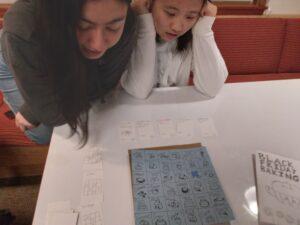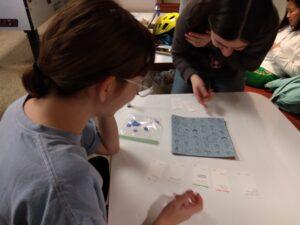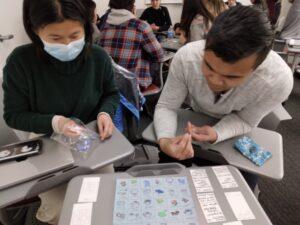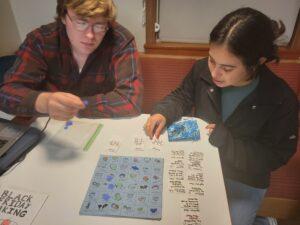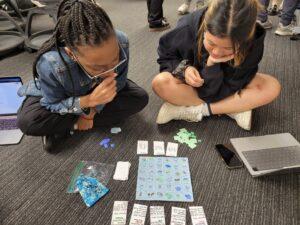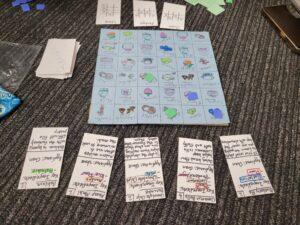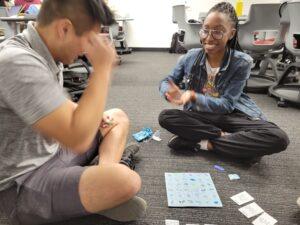Game Makers: Yasmine Mitchell, Alejandro Cid
Concept Statement:
Although a deceptively straightforward pastime, baking can be very intimidating for people just starting out. To address this hurdle, we designed a 2-player competitive game that would teach players recipes and facts about baking.The recipes included in the game are relatively comprehensive so an inspired player might apply the recipes from the game to create delicious goods for their friends. We purposely included more obscure bakes and recipes that require interesting and surprising twists. For an example of the former, we included marzipan and mango sticky rice—two deserts from different cultures that certain people are likely to not have run into (myself included). And for an interesting twist about a recipe that I learned while doing research for this project—I didn’t know that espresso is often included in chocolate cake in order to bring out the decadent flavor of the chocolate. We hope to test the teaching potential of our game by polling players after playtesting in class.
Our game is a strategic competitive game where players vie for resources on a 6×6 board where each tile represents an ingredient. They will have to plan ahead to place their chips wisely in order to build recipes faster than their opponent, while also paying close attention to the enemy’s moves. Because of the strategic thinking required, we think the game will include the Challenge kind of fun. Furthermore, in previous playtests we noticed that despite competing against each other, players engaged in banter and talking about the thematic elements of the game. The game seemed to bring the two competing players closer together, therefore we believe it contains the Fellowship type of fun.
At the end of the game this is a strategic game where players compete for control of the board—there are many games of varying complexity that exist in this vein. A simple example is Tiny Towns where players control a small board by building a village. A significantly more complex example is Civilization, where players build, scout, trade, and even go to war to become the most powerful civilization in the game world.
Our biggest concern when developing this game was/is balancing it in such a way so that it is competitive, fun, and fair. The main things we’d need to get right in order to achieve this are the amount and size of recipes, the amount of ingredients, and the size of the board. This is a surprisingly difficult task as, despite the simple rules of the game, there are several areas of complexity in the size of the recipes, the boards, the amount of ingredients, the overlap of ingredients between recipes, and metagame tactics like blocking—since each one of these areas affects the others, changing one can have cascading consequences on the whole game.
Assessment Goals:
We had three assessment goals. The player would report that: they would play again (1), they learned something new about baking or about a new dessert (2), and the game felt relatively balanced (3). After each pair playtested the game, we gave the players a form to fill out to determine if we reached these goals.
For the original version of the game, we didn’t completely achieve the first two goals. Testers said they would play the game again, but only after a few changes to gameplay mechanics. For the second goal, they felt like there wasn’t enough context given for the desserts. As such, even if the dessert cards they drew were new to them, they didn’t really retain the information. Players said we did succeed in making the game balanced enough.
We worked toward solving those problems in our current version of the game by making the recommended changes to game mechanics. This included increasing the difficulty of acquiring appliances, as well as making it so that a recipe can be claimed by only one player. We also added dessert fun facts to the cards to add more opportunities for learning. If we have more time in future, we’d also like to add full recipes to the cards. It’d be a great way to achieve our learning goals, while also giving a second purpose for our game: making it a cookbook.
History:
- Version A (Initial Idea)
- The original idea for the game came from the tic-tac-toe exercise during the first class. I wanted to use my game to teach people how to bake. I ended up modding tic-tac-toe so that each “square” represented an ingredient, and you competed with someone else to get ingredients for certain recipes first.
- Version 0
- This is the initial plan we came up with when we decided to adapt the recipe game for Project 1. The board was 8 by 8 instead of 6 by 6, and each recipe had a lot more ingredients. Additionally, most of the ingredients on the board were “staple” ingredients (flour, sugar, baking powder, salt, etc), and specialty ingredients were few and far between. Additionally, almost all of the recipes we picked were desserts common in the U.S. (chocolate chip cookies, chocolate cake, donuts, pancakes, etc). During this phase, we also came up with the idea to have configurations that the players would have to make on the board, in addition to having to obtain ingredients. For example, in order to complete the “whisk” action for a recipe, you have to get four markers in a row.
- Version 1
- This was the first prototyped, playable version of the game. Before we made our game pieces, we got some feedback on our plan. This led to us changing our desserts to represent a more diverse set of cultures, as we wanted not just to teach people how to bake, but to also expand their knowledge of what desserts were out there. We also simplified the recipes to contain just a few key ingredients, in addition to shrinking the board to 6×6. Finally, we changed the “actions” mechanic to be about creating “appliances” instead (like ovens, for example).
- Version 2
- The focus for this version of the game was to improve the way our game presented information visually, both for aesthetic reasons and to make the game easier to play. We added pictures to the ingredients on the game board. We also made a whimsical rule book for the game. Later on in this version, we also added colors to the images on the board, the rule book, and the game cards. Additionally, we added “fun facts” about the desserts to their recipe cards. We also made it so that the same ingredient marker couldn’t be used for more than one recipe.
- Version 3
- For this final version, we focused on improving gameplay mechanics and game balance. Playtesters reported that the game slowed down after 1 or 2 recipes out of the 5 were claimed. Therefore, we changed it so that the players drew 3 recipes at the beginning (instead of 5), and instead of only drawing recipes at the beginning of the game, they drew a new recipe each time one was claimed. Similarly, players said that it was hard to make more than one appliance, so we updated the rules to allow the configurations to “wrap” around the board.
Playtester Photos:

